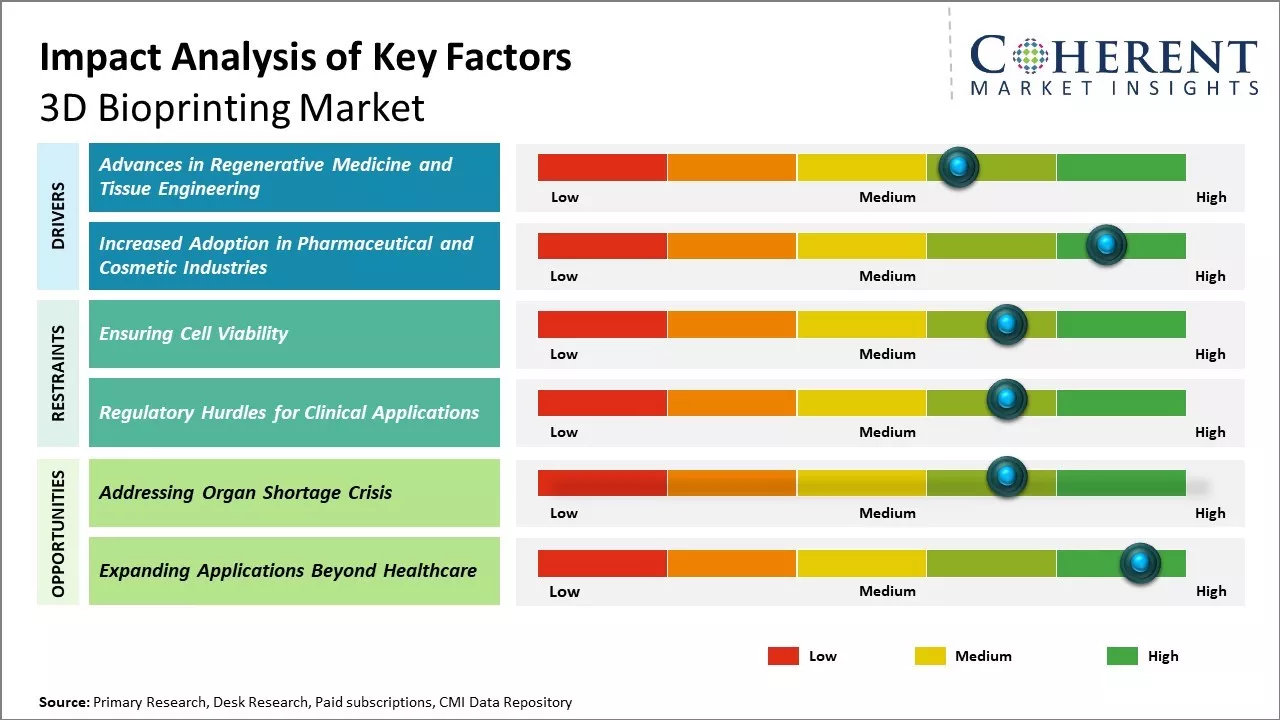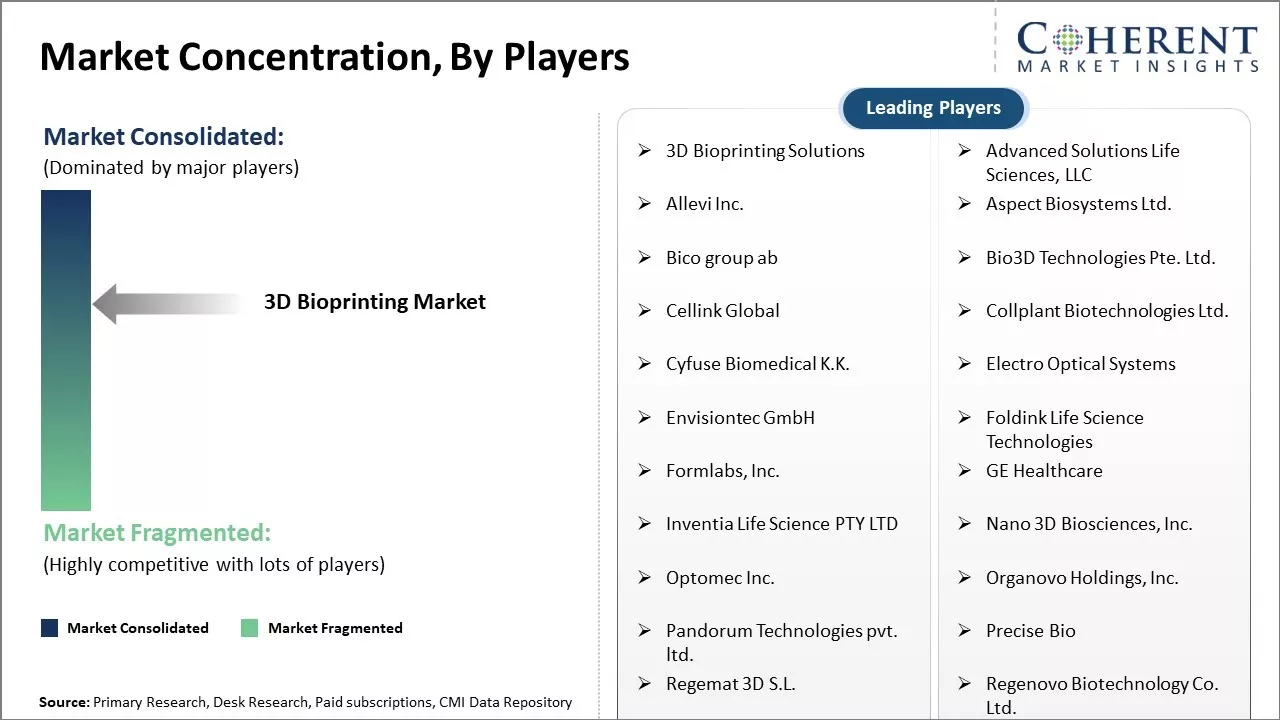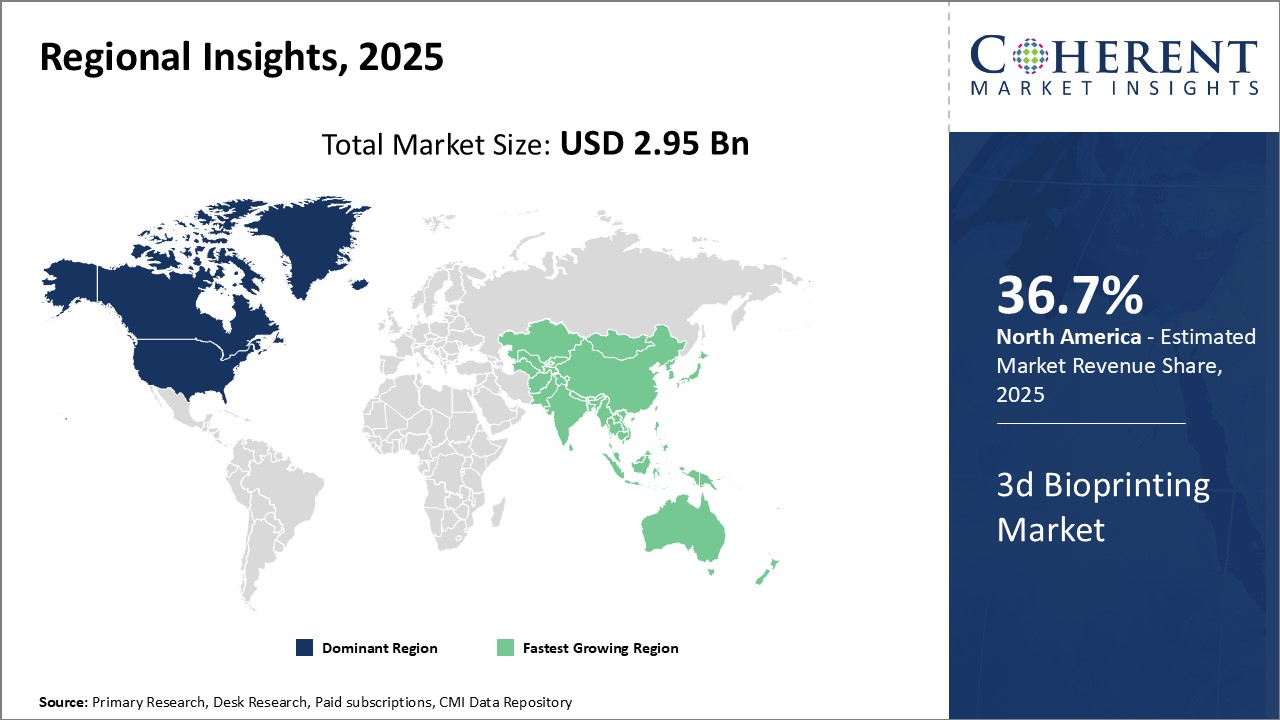
The 3D bioprinting market is estimated to be valued at USD 2.95 Bn in 2025 and is expected to reach USD 8.53 Bn by 2032, growing at a compound annual growth rate (CAGR) of 16.4% from 2025 to 2032

To learn more about this report, Download Free Sample
The global 3D Bioprinting Market is experiencing steady growth, fueled by advancements in tissue engineering, regenerative medicine, and drug development. The technology enables the precise fabrication of living tissues and organ models, offering significant advantages in personalized medicine and pharmaceutical testing. Key growth drivers include increased R&D investment, demand for alternative testing models, and rising organ transplant shortages. North America leads the market, followed by Europe and Asia Pacific, with strong healthcare infrastructure and innovation hubs accelerating adoption and commercialization.
|
Current Event |
Description and its impact |
|
Accelerating Investments in Regenerative Medicine |
|
|
Technological Advancements and Automation in Bioprinters |
|
|
Regulatory Shifts and Standardization Efforts |
|
Uncover macros and micros vetted on 75+ parameters: Get instant access to report
Advanced technologies play a pivotal role in accelerating the growth and capabilities of the 3D bioprinting market. Innovations in bioink formulation—such as smart hydrogels, decellularized extracellular matrices, and stimuli-responsive materials—enhance the biocompatibility, precision, and structural integrity of printed tissues.
Next-generation bioprinters equipped with high-resolution inkjet, extrusion, and laser-assisted technologies enable the creation of complex, multi-layered biological structures that closely mimic human tissue architecture. Integration with AI and machine learning is improving process automation, real-time monitoring, and optimization of print parameters, thereby increasing reproducibility and reducing error rates.
Additionally, advancements in microfluidics and organ-on-a-chip technologies are expanding the scope of 3D bioprinting in drug screening and disease modeling. Cloud-based platforms and digital modeling tools also support remote design, simulation, and customization of biological constructs. These technological advancements are not only enhancing research outcomes but also bringing 3D bioprinting closer to clinical and commercial scalability in regenerative medicine and pharmaceuticals

To learn more about this report, Download Free Sample
3D bioprinting has opened new avenues for advancements in regenerative medicine and tissue engineering. Traditional tissue engineering techniques have limitations in developing complex living tissue constructs that mimic natural tissues. With 3D bioprinting, researchers can bio print tissues and organs layer-by-layer with variable cell types, growth factors and biomaterials to better recapitulate the biological, mechanical and structural properties of natural tissues. Complex 3D printed tissues have been made containing blood vessels which was challenging to achieve earlier. Bioprinting also allows printing of patient-specific tissues with potential for disease modelling and development of personalized treatment options.
For instance, in May 2022, Regemat 3D which is a creator of living tissue technologies, secured over USD 545,000 to advance its 3D bioprinting technology, encompassing software, a bioreactor, materials, and accessories. The firm's portfolio includes the BIO V1 and REG4LIFE 3D bioprinters designed for disease modeling, drug testing, and organ-on-a-chip applications. The BIO V1 offers precise movements in the X, Y, and Z axes, while the REG4LIFE facilitates independent Z-axis movement, enabling the use of two syringes on multi-well plates.
In April 2025, Reuters reported on a team of Australian biomedical engineers who created a flexible robot capable of performing 3D bioprinting inside the human body. This innovative, minimally invasive technology enables biomaterial printing directly at tissue damage sites, advancing potential surgical repair and regenerative medicine applications.
The burgeoning applications of 3D bioprinting in the pharmaceutical and cosmetic industries is emerging as pivotal drivers for the 3D bioprinting market. In drug discovery, the utilization of 3D bioprinted human tissues facilitates effective compound screening, toxicity analysis, and the development of tissue-based assays.
This approach enhances the predictability and reliability of preclinical studies, surpassing the limitations of conventional 2D cell culture models. The pharmaceutical sector is actively embracing bioprinting to expedite the development of new drugs and bio-therapeutics, with a focus on personalized approaches.
The dynamic landscape of the healthcare sector in India, identified as one of the fastest-growing industries, contributes significantly to the 3D bioprinting market's growth. With the sector projected to triple to USD 133.44 billion ( INR 8.6 trillion) by 2022 and India's commitment to increasing public healthcare spending from 1.2% to 2.5% of GDP by 2025, these trends create a favorable environment for the adoption and expansion of 3D bioprinting technologies in the country. This convergence of factors positions the 3D bioprinting market to experience substantial growth, driven by the increasing demand across diverse applications in the pharmaceutical and cosmetic sectors.
In April 2025, Medical Xpress reported that a team from the National University of Singapore combined AI with 3D bioprinting to personalize oral soft tissue grafts. Their method optimizes parameters to create customized gingival grafts, enhancing precision and reducing patient discomfort.
The ability to custom design and print living grafts, implants and eventually whole organs on demand could revolutionize transplants and regenerative medicine. It offers potential solutions for replacing damaged tissues and addressing organ shortages. As bioprinting methods advance, opportunities will grow in healthcare, drug testing and cosmetics.
Inkjet bioprinting is projected to hold the largest market share of 43.4% in the global 3D bioprinting market by 2025. This segment leads due to its ability to print high-resolution, complex structures using multiple bioinks simultaneously.
The drop-on-demand technology, coupled with advancements in nozzle design, supports precise deposition of cells and biomaterials, making it suitable for both tissue engineering and pharmaceutical testing. Its low cost, high speed, and compatibility with low-viscosity bioinks further contribute to widespread adoption across academic institutions and biotech firms
Biomaterials are anticipated to account for 45.48% of the 3D bioprinting market in 2025. These materials—including hydrogels, decellularized extracellular matrices, ceramics, and synthetic polymers—are critical for mimicking the native cellular environment in engineered tissues.
They provide structural support, cell adhesion, and nutrient diffusion properties essential for tissue development. Ongoing innovation in bioink composition and crosslinking methods is expanding the functional range of biomaterials, reinforcing their dominant role in clinical and research applications.
The drug testing and development segment is expected to contribute 34.78% to the global market share by 2025. 3D bioprinting enables the creation of physiologically relevant tissue models that improve the predictability of preclinical studies. These models offer enhanced insights into drug efficacy, toxicity, and pharmacokinetics, supporting the shift toward personalized medicine.
The reduced reliance on animal testing and the potential to lower R&D costs make bioprinted tissues highly attractive for pharmaceutical companies aiming to optimize and accelerate drug pipelines.

To learn more about this report, Download Free Sample
North America is projected to maintain its lead in the global 3D bioprinting market with a 36.7% share in 2025, with the United States acting as the primary growth driver. The region benefits from a well-established biotechnology and pharmaceutical ecosystem, significant R&D funding, and active collaboration between research institutions, medical device manufacturers, and bioprinting startups. Favorable regulatory frameworks and early adoption of advanced technologies further reinforce North America's leadership in bioprinting innovation and commercialization.
Europe holds a significant share in the global 3D bioprinting market, supported by a strong focus on healthcare innovation, regenerative medicine, and personalized therapeutics. Countries such as Germany, the United Kingdom, France, and the Netherlands are leading bioprinting research initiatives and clinical collaborations. EU-backed funding for biomedical research and emphasis on reducing animal testing in drug development are also key factors contributing to regional market growth.
The United States leads the global 3D bioprinting market, driven by robust R&D funding, a mature biotechnology ecosystem, and a high level of integration between academia, startups, and pharmaceutical giants. The country’s advanced manufacturing infrastructure and favorable regulatory environment support rapid commercialization of bioprinting technologies.
Additionally, major investments by the NIH, NSF, and private sector in regenerative medicine and personalized healthcare accelerate market innovation.
| Report Coverage | Details | ||
|---|---|---|---|
| Base Year: | 2024 | Market Size in 2025: | USD 2.95 Bn |
| Historical Data for: | 2020 To 2024 | Forecast Period: | 2025 To 2032 |
| Forecast Period 2025 to 2032 CAGR: | 16.4% | 2032 Value Projection: | USD 8.53 Bn |
| Geographies covered: |
|
||
| Segments covered: |
|
||
| Companies covered: |
3D Bioprinting Solutions, Advanced Solutions Life Sciences, LLC, Allevi Inc., Aspect Biosystems Ltd., Bico group ab, Bio3D Technologies Pte. Ltd., Cellink Global, Collplant Biotechnologies Ltd., Cyfuse Biomedical K.K., Electro Optical Systems, Envisiontec GmbH, Foldink Life Science Technologies, Formlabs, Inc., GE Healthcare, Inventia Life Science PTY LTD, Nano 3D Biosciences, Inc., Optomec Inc., Organovo Holdings, Inc., Pandorum Technologies pvt. ltd., Precise Bio, Regemat 3D S.L., Regenovo Biotechnology Co. Ltd., Renishaw plc., Revotek co., ltd., Rokit Healthcare, inc., Stratasys Ltd.Vivax Bio, LLC, and Vivax Bio, LLC |
||
| Growth Drivers: |
|
||
| Restraints & Challenges: |
|
||
Uncover macros and micros vetted on 75+ parameters: Get instant access to report
Share
Share
About Author
Monica Shevgan has 9+ years of experience in market research and business consulting driving client-centric product delivery of the Information and Communication Technology (ICT) team, enhancing client experiences, and shaping business strategy for optimal outcomes. Passionate about client success.
Missing comfort of reading report in your local language? Find your preferred language :
Transform your Strategy with Exclusive Trending Reports :
Frequently Asked Questions
Joining thousands of companies around the world committed to making the Excellent Business Solutions.
View All Our Clients